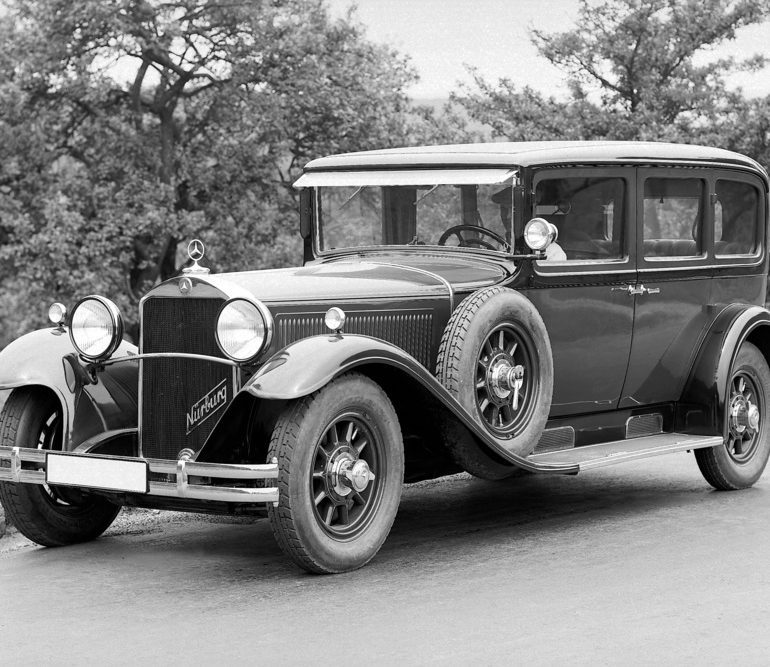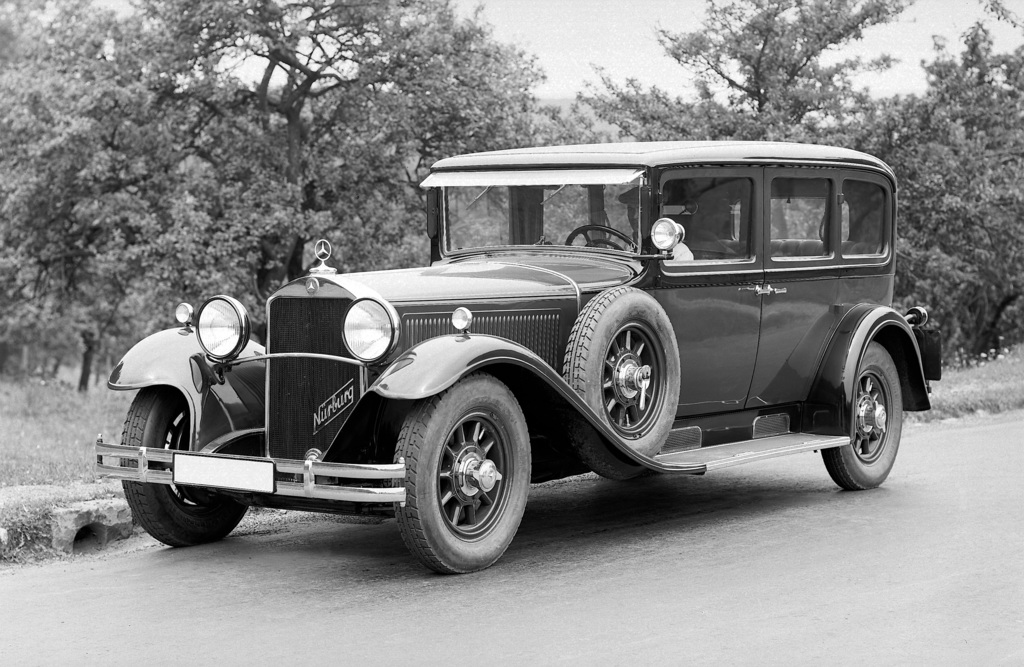1928→1933 Mercedes-Benz 460 Nürburg
Mercedes unveiled their Typ Nürburg 460 as their first eight-cylinder passenger car and it was typically fit with luxurious bodies to rival the Horch 8.
Ferdinand Porsche developed the new inline eight which used side-valves to produce 80 bhp. It was rated as the 18/80 PS.
Bodywork options for the 460 included a Limousine, 6-passenger Tourenwagen, a four-door Cabriolet D and numerous variants of these. The 460 could be ordered as a rolling chassis for independent coahcwork.
For 1929 Technical Director Hans Nibel reworked the 460 chassis to an under slung design that greatly reduced the height of the bodywork.
One particularly famous Nürburg 460 was gifted to Pope Pius XI and included a Pullman Limousine body from the 770 Großer that was untypical for the smaller chassis.
2883 copies of the Nürburg 460 chassis were produced at the Manheim factory which was joined by the larger Nürburg 500 after 1931.
Press Release
With hindsight it was not the most auspicious timing for a premiere. In October 1928 – just a year before the start of the Great Depression – the 18/80 hp Mercedes-Benz Nürburg 460 (W 08 series) made its debut at the Paris Motor Show. Generously proportioned in every sense, the vehicle was aimed essentially at a wealthy clientele – not perhaps the most “opportune” customer base given the circumstances of the day.
But then there was always the alternative perspective, for although the well-off had lost considerable amounts of money on the turbulent international markets, many had managed to manage their finances with care and put enough to one side to buy a new car – and make a statement in so doing. Then as now, a Mercedes-Benz was considered a sound investment. And for Mercedes-Benz the story had a happy ending, since in relative terms the W 08 enjoyed great popularity in the luxury and prestige class over a production lifetime of eleven years.
The Nürburg – as the vehicle became more familiarly known – was the last pillar of the new joint model programme following the merger of Daimler-Motoren-Gesellschaft and Benz & Cie. in 1926 to form Daimler-Benz AG.
It was seen as the successor to the 15/70/100 hp six-cylinder supercharged model and underwent a hurried development under the supervision of Ferdinand Porsche. Other brands were already enjoying considerable success in the luxury vehicle segment, not least among them the Horch 8 produced by the German competitor Horch, a vehicle developed by none other than Paul Daimler after Daimler-Motoren-Gesellschaft had originally rejected his design.
The Nürburg was the first series model from Mercedes-Benz to feature an eight-cylinder engine. For this reason it was often referred to in some publications as the Nürburg 8, and the cover of early catalogues is adorned with a golden figure 8 embedded in a lozenge shape. It was christened the Nürburg not as a reference to any particular sporting ability, but rather as a tribute to its reliability – during endurance testing on the Nürburgring the vehicle had clocked up 20,000 kilometres in just 13 days and nights.
Revised variant appears on the scene as early as 1929
Built initially on a high-frame chassis, there was much about the Nürburg that resembled the stocky and impressive fortress its German name suggested. Yet at the same time it was rather old-fashioned and antiquated in appearance; vehicle construction and design had moved on and adopted new laws. Soon after its debut, therefore, the model underwent a thorough revision and was equipped with a low-frame chassis – one of the first tasks of Hans Nibel, Daimler-Benz’s chief designer who succeeded Porsche on January 1, 1929. The now much more visually pleasing Nürburg was again presented at the 1929 Paris Motor Show. The lower-slung vehicle had a longer, more elegant look, and was now every bit the equal of its competitors in terms of external appearance.
The power unit was an eight-cylinder in-line engine developing 80 hp (59 kW) from a 4.6-litre displacement in combination with a four-speed transmission. By popular demand it was joined in 1931 by a more powerful variant that developed 100 hp (74 kW) from a 4.9-litre displacement. This model was not officially available until later as the 19/100 hp Nürburg 500; for the not inconsiderable surcharge of 2,000 Reichsmark this variant came not only with the more powerful engine, but also an economy gear or “overdrive”, engaged to reduce engine speed for each of the four forward gears, and high-quality, high-performance Zeiss headlamps. From September 1932, an overdrive was also available on the 460 model at a surcharge of 1,400 Reichsmark.
Whereas the 500 was produced solely as a long wheelbase version, the 460 model was additionally available as a 240mm-shorter version bearing the additional designation letter “K” – not to be confused with the “K” in the name of the later supercharged vehicles. The shorter chassis was 50 kg lighter and fitted with 4/5-seat bodies, available as a saloon, open-topped tourer and Convertible D. The low-frame variant of the 460 K was also still available as the “St. Moritz” special convertible C. This model acquired the illustrious name of the winter sports venue in the Swiss Engadine region after the car beat all other competitors in an automotive beauty pageant in early 1930.
One special version of the Nürburg 460 built on the short chassis did not appear in any brochure or price list: a two-seater sports roadster, two examples of which were used in motorsports events. In the international Alpine Rally of 1929, Rudolf Caracciola and Otto Merz covered a distance of 2,660 kilometres in these unusual sports cars, as well as completing the eight-hour ADAC long-distance race for non-supercharged touring cars on the Nürburgring.
A large range of body variants
The Nürburg with long wheelbase was available as an open-topped touring car and Pullman limousine, each with 6 or 7 seats. In late 1931 the model range was joined by a 6/7-seat Convertible F, although this came not with a Sindelfingen body, but instead with bodies built by the external firms of Neuß, Erdmann & Rossi, Voll & Ruhrbeck, Papler and Gläser. In-house bodies for the other variants were produced not just at the Mannheim plant, which built all model variants of the Nürburg, but also at Sindelfingen to some extent. For a handful of VIP customers such as Pope Pius XI, the Nürburg was also fitted with the Pullman body of the Grand Mercedes. As was usual at the time, customers could also purchase a bodyless chassis with a view to having an external coachbuilder fit it with a custom-built body. To this end the chassis were available in both wheelbase lengths. A very special variant of the Nürburg was built in February 1931 – a special-protection Pullman limousine, which was documented in a series of contemporary archive photographs.
Production of the Nürburg 460 ended in December 1933. In February 1934 the Nürburg 500 model was renamed 500. This led to some confusion, since just a month later saw the arrival of the “supercharged 500” – better known today as the 500 K. In order to differentiate between the two vehicles the company introduced the designations 500 N and 500 K.
Technical differences between the 500 and 500 N were slight. More distinctive was the restrained modernisation of the bodies, which had nevertheless begun as an ongoing process during the last model year of the Nürburg 500. One clearly recognisable innovation – although still relatively discrete – was the slightly inclined wedge-shaped radiator, which in the 500 N replaced the flat radiator grille of its predecessor. By now the factory-built bodies also featured at least slightly inclined front windscreens, previously the preserve of the St. Moritz convertible and designs from external coachbuilders. Summer 1935 saw the presentation of a further revised design, this time with a more pronounced inclination of both the front windscreen and the radiator grille. In mid 1936 a further technical modification was introduced: the compression was raised to increase engine output to 110 hp (81kW). Throughout the entire production period, the 500 was available as a Pullman limousine and as an open-topped touring car. Originally also available, the Convertible C, D and F models were discontinued one by one at the start of model years 1937, 1938 and 1939.
When the last seven examples of the W 08 series came off the production line in October 1939, they marked in many ways a significant watershed.
After eleven years in production, it was the end of the longest production period for any passenger car series built at Daimler-Benz during the pre-war years. But the last produced model, the 500 N, was also the last passenger car from Mercedes-Benz to be equipped with a rigid axle, and the last passenger car worldwide to be supplied with wooden-spoke wheels. And finally the 500 N brought to an end the historic production of passenger cars at Daimler-Benz’s Mannheim plant.
In general terms the balance sheet made attractive reading: 1,385 examples of the Nürburg 460 and 460 K models with high-frame chassis were built between 1928 and1929, together with 1,508 low-frame chassis units from 1929 to 1933. Between 1931 and 1939 a total of 931 units of the Nürburg 500 and 500 N models were built. This gave a final production figure of 3,824 vehicles – an impressive achievement for any model series in the luxury segment at the time.
Story by Richard Michael Owen
In Detail
| tags | W08 |
| submitted by | Richard Owen |
| type | Series Production Car |
| production years | 1928 – 1933 |
| built at | Manheim, Germany |
| engineers | Ferdinand Porsche |
| production | 2883 |
| engine | Inline-8 |
| position | Front, Longitudinal |
| aspiration | Natural |
| displacement | 4622 cc / 280.71 in³ |
| power | 58.9 kw / 79 bhp @ 3400 rpm |
| specific output | 17.09 bhp per litre |
| front brakes | Drums w/Bosch-Dewandre Vacuum Assist |
| rear brakes | Drums w/Bosch-Dewandre Vacuum Assist |
| f suspension | Solid Axle w/Semi Elliptic Leaf Springs |
| r suspension | Live Axle w/Semi Elliptic Leaf Springs |
| wheelbase | 3670 mm / 144.5 in |
| transmission | 4-Speed Manual |





